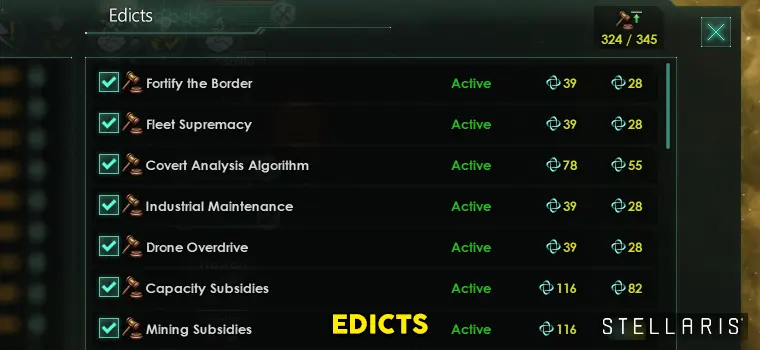Unity is one of the abstract resources in Stellaris among influence and research. They increase the empires sociopolitical and technological capabilities immensely. Everyone knows unity is for completing traditions. Though only 7 traditions can be completed. Then what? There is one question on beginner players’ minds: Where to spend excess unity in Stellaris? Unity surplus explained below.
You should never spend unity on things other than traditions at the beginning. Rushing traditions ASAP is really important because tradition adaptation costs increase over time with the empire size. Once you complete all traditions, you can relax and start spending unity on ascensions, edicts, leaders, planetary decisions, government reforms, and agendas. These are the possible uses of excess unity in Stellaris.
I shall now explain the most optimal ways of using unity in the order of importance starting with planetary ascension.
Planetary Ascension


Planetary ascension is the best. It reduces empire-size, increase resources from jobs, and reduce upkeep.
I basically rush traditions on all my Stellaris runs so that I can start ascending planets. Especially the capital, ecumenopolis’, hive worlds, machine worlds, and ring segments. Always ascend the worthy planets because planetary ascension cost is multiplicative.
It’s very easy to hit ascension level 10 with the first few planets. Then the cost became too high.
Most new players miss the planetary ascension button. It’s the little ∧ button right next to the planet designation bar. Very easy to miss. In fact, I know some Stellaris players who played +500 hours and still was unaware of the planetary ascension. (Definitely not me… Okay, that was me.)
For more tips on world ascension tiers, read my Stellaris planetary ascension guide.
Run Edicts


Here is the thing, edicts are powerful. Especially the research, alloy, unity, and energy boosting ones. However, spending unity on edicts is not recommended before completing all traditions.
Thankfully you can run some edicts on edicts fund without spending any unity. Edicts fund is a separate pool on unity for edicts upkeep, if upkeep exceeds the pool, standart unity will be used. Edicts fund limit can be increased by civics, technologies, rulers, nodes, and some unique buildings.
Best Stellaris edicts:
- Map the stars: +25% survey speed and +10% anomaly discovery chance bonuses are godly in the early game.
- Astral binding: +10% resources from jobs. Better build astral siphon buildings to run this edict because it cost astral threads instead of unity.
- Veneration of saints: +20% priest output, insane unity bonus.
- Research subsidies: +10 researcher output.
- Forge subsidies: +10% metallurgist output.
- Living metal mega constructions: +50% megastructure build speed is insane because megastructures are very slowly built.
- Capacity subsidies: +50% technician output. Energy is king.
- Terraforming gasses: +50% terraforming speed can save up to 5 years.
- Industrial subsidies: +10% consumer goods output.
- Baryonic insight: +10% monthly physics research.
Recruit Lots of Leaders


Recruiting leaders and their upkeep cost unity. That’s why I try to avoid going overboard with the leaders before completing traditions.
But I go wild with leaders after completing traditions. Even going over the leader limit is okay because leader unity costs aren’t very too high. Besides, we have surplus of unity after completing traditions remember.
Beating end-game crisis faction requires at least 20 full naval units. Recruiting 20 mercenary enclave admirals for your end-game fleets is a worthy investment, believe me.
Planetary Decisions


Some cost unity, some cost minor artifact, some cost energy. Planetary decisions can boost your planet or save it from bad situations.
They are all situational and don’t cost much unity. Therefore, you can take them whenever you need, even before completing traditions.
Stellaris planetary decisions that cost unity to take:
- Launch anti-crime campaign.
- Negotiate with crime lords.
- Expel excess population.
- Declare population controls.
- Discourage planetary growth.
- Cease robot assembly.
- Cease drone production.
- Activate oracle nexus.
- Implement divine algorithm.
- Consecrate world.
- Create penal colony.
- Create resort world.
- Create thrall-world.
- Create gestation world.
Reform Government


Reform government action in Stellaris is all about introducing new civics and removing the old ones. It cost very small amount of unity.
Player empires start with 2 civics. Then a third civic can be introduced after researching galactic administration tech. Another civic can be introduced after becoming the galactic emperor.
Adding a new civic will also clear all your council positions. So, leaders must be assigned to empty councilor slots right after reforming the government.
Agendas


You can instantly complete government agendas by spending unity. It’s not recommended except on certain situations. Like tech agendas that are necessary to adopt species ascension traditions like engineered evolution, psionics, and synthetic age.
Though in some instances, I used unity to launch early agenda for dark matter breakthrough. Because I badly needed new dark matter tech to defeat the strongest Stellaris crisis faction.
Other than that, I wouldn’t launch early agenda by spending my unity. I would rather ascend planets with excess unity. Because ascending planets is the best way of spending unity other than completing traditions.
I’ve shared 6 different ways to spend unity, I hope now you know where to spend excess unity in Stellaris. Just keep in mind, most optimal way of spending excess unity is planetary ascension.













